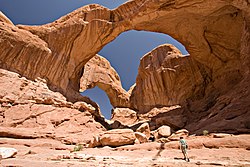| | |
| Formation | April 30, 1937 [1] |
|---|---|
| Founders | Bob Marshall, Benton MacKaye, Aldo Leopold, Bernard Frank, Robert Sterling Yard, Harvey Broome |
| 53-0167933 [2] | |
| Legal status | 501(c)(3) nonprofit organization [2] |
| Headquarters | 1801 Pennsylvania Ave NW, 2nd Floor, Washington, D.C. 20006, U.S. |
| Coordinates | 38°54′21″N77°02′14″W / 38.905927°N 77.037329°W |
| Membership | 1+ million [3] |
| Tracy Stone-Manning [4] | |
| Subsidiaries | The Wilderness Society Action Fund (501(c)(4)) [5] |
| Revenue | $30,081,869 [5] (2017) |
| Expenses | $31,030,390 [5] (2017) |
| Endowment | $19,919,430 (2017) [5] |
| Employees | 165 [5] (2016) |
| Volunteers | 125 [5] (2016) |
| Website | www |
The Wilderness Society is an American non-profit land conservation organization that is dedicated to protecting natural areas and federal public lands in the United States. They advocate for the designation of federal wilderness areas and other protective designations, such as for national monuments. They support balanced uses of public lands, and advocate for federal politicians to enact various land conservation and balanced land use proposals. The Wilderness Society also engages in a number of ancillary activities--including education, outreach, and hosts one of the most valuable collections of Ansel Adams photographs at their headquarters in Washington, D.C. [6]
Contents
- Founding
- Founders
- Notable associates
- Achievements
- The Wilderness Act of 1964
- More than 109 million acres designated as wilderness
- Passage of conservation laws
- Major court cases
- Significant accomplishments
- Issues and campaigns
- Automobiles
- Expanding protections for public wildlands
- Views on logging and mining
- Views on geothermal energy
- Public land production
- Awards
- The Ansel Adams Award
- The Robert Marshall Award
- See also
- References
- Further reading
- External links
The Wilderness Society specializes in issues involving lands under the management of federal agencies. These lands include national parks, national forests, national wildlife refuges, and areas overseen by the Bureau of Land Management. [7] Since the early 21st century, the society has actively fought recent political efforts to reduce protection for America's roadless, undeveloped lands and wildlife.
The organization was instrumental in the passage of the 1964 Wilderness Act. [8] The Wilderness Act led to the creation of the National Wilderness Preservation System, which protects 109 million acres of U.S. public wildlands. [9]









